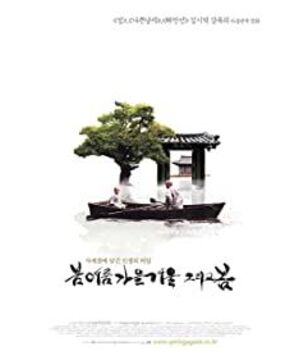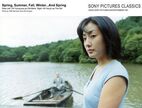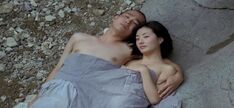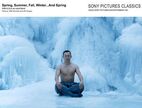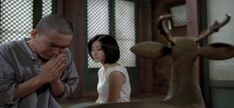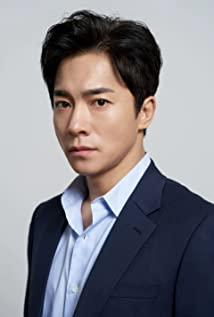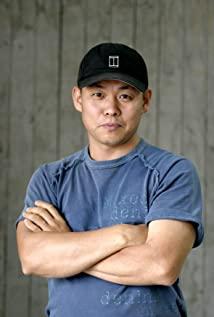In the plot, the director tells the story of reincarnation using the natural reincarnation of spring, summer, autumn, winter, and spring as its markers.
Spring: An old monk and a child live in a lonely temple on the water far away from the world. The child tied the stone to the little fish and snake out of curiosity. Seeing his deeds, the old monk drew a gourd and tied the stone to him, educating him to look at everything around him with the same mood. When the child carried the stone on his back, he uncovered the stone for the little fish and the snake, and found that he had made an unforgivable mistake. He cried bitterly at the corpse of the little fish and the snake.
Summer: Children have grown into young monks. One day a sick girl came to the temple. The young monk couldn't resist the temptation, and finally ate the forbidden fruit with the girl. The old monk found out about the two of them, and the girl had recovered from the illness, so she sent the girl away. The young monk couldn't bear the pain of losing his lover. In the night, carrying the only Buddha statue in the lonely temple, secretly left.
Autumn: The young monk becomes a wife murderer because his wife cheated. He had nowhere to escape and returned to the lonely temple where he was raised. Due to the suffering of life, he is no longer the original peaceful appearance, his face is surly and his heart is full of anger. The old monk enlightened him and ordered him to seal the Prajna sutras on the ground with heart to purify his violent heart. After dawn, the murderer was safely taken away by the police.
Winter: The murderer who was released from prison is middle-aged. He returned to the monastery, and the old monk has passed away. One night, a woman came to the temple with a baby and wept bitterly in front of the Buddha statue. A few days later, when the woman was planning to abandon the baby and leave secretly, she fell into an ice cave on the lake and died. The middle-aged monk adopted the baby. The middle-aged monk finally realized enlightenment. He sank the old Buddha statue into the lake, carried the stone on his back, and climbed to the top of the mountain with the new Buddha statue in his arms. When he reached the top of the mountain, the lonely temple in the lake and even the entire lake was against the backdrop of the mountains. The next seems insignificant...
It’s another spring: the child monk is doing exactly the same prank, putting the stone into the mouth of the little fish and the snake...
In my opinion, spring, summer, autumn, and winter correspond to the Buddhist philosophy. The four stages of becoming, abiding, bad and empty, from curiosity, innocence, and unrealized “being”, to “staying” full of instinct and desire (possessive and eros), and then from love to hate and full of violence The "bad" and anger are finally attributed to the "emptiness" of the silence and emptiness, which reflects the origin of life, and another spring should be a kind of interpretation by the director, reflecting the director's deep sadness for human beings unable to escape the destiny and nature.
I don't know if the director believes in Buddha and wants to convey the teachings of Buddha to the audience, but in my opinion, the whole film is full of Buddhist scriptures, and in those obscure and subtle pictures, there are implied Zen motifs everywhere. Metaphors and symbols are everywhere in the scene design that seems to pursue aesthetics. Here, I briefly talk about my understanding.
The first is the door. The door is undoubtedly a symbol of taboo in the film. From the unwalled gate in the lonely temple in the lake to the opposite door in the temple without a wall, the door represents a kind of taboo and norm, although there is no wall. , But in the film, everyone still goes out and enters, opens and closes according to the rules. It is not until the young monk is cheating on, that he jumps over the “wall” and throws into the arms of the girl without going through the door.
The lonely temple located in the lake represents everyone’s world. The lonely temple stands alone in the middle of the lake, unable to move, and quietly undergoing the changes of the four seasons. It has no contact with the outside world and wants to walk to the lake. The only means of transportation is the small boat, and those who come by accident are causal and fate. In the early stage of the movie, the lone temple represents the world of the old monk. Like the old monk, it is indifferent to the world and independent of the world. The heart is not moved, so the temple does not move. Regardless of the changing seasons and the visitors, the lone temple is always watching silently. After the old monk passed away, the entire temple began to move in the picture. The lonely temple in the later period heralded the world of the middle-aged monk, and the women and orphans in the turban were cause and effect. After the middle-aged monk attained enlightenment, he climbed the mountain and finally found that his world was nothing but a grain of sand. The ultimate care for the world.
The Buddha statue symbolizes the understanding and enlightenment of the world. At the beginning of the movie, there was only one Buddha statue in the lonely temple that had been damaged. The old monk carefully cleaned the Buddha statue. When the young man left the temple, he took the Buddha statue away, indicating that he did not really understand it. At the stage of "being", he wanted to not forget his past and known truths by owning the Buddha statue. When he killed his wife in anger, he brought the Buddha statue back to the temple. The Buddha statue did not teach him to forget his anger. And when he finally attained enlightenment, he sank the old Buddha image into the lake, and he finally had his own "new Buddha".
The only tool of communication between the lonely temple and the shore is the dilapidated boat. The boat symbolizes the passage for us to communicate with the outside world. When the old monk saw the police escorting the young man he grew up to leave, he couldn't help but feel moved. , So no matter how you row, the boat can’t move forward. Only when the old monk let go, can the boat move on. The ship also brought a fate with the outside world. Whether it was the arrival of the sick girl, the law enforcement police, or the return of the murderer, they all came to the Shuigu Temple through the ship.
The stone is the double symbol of sin and salvation. At the beginning, the young monk helped the little fish on the stone because of curiosity and fun. When the old monk tied the stone to him, he was redeemed because he experienced "suffering". , When he saw sentient beings die because they were carrying "stones" that shouldn't be carried on their backs, he finally realized the suffering of sentient beings and wept bitterly. After the middle-aged monk attained enlightenment, he finally understood that troubles are bodhi. He climbed to the top of the mountain with a large stone on his back and a Buddha statue in his arms, which foretells that he will eventually be redeemed from sin and burden.
The stone lion in front of the temple. When the girl first came, she sat on it. The young monk told her not to sit. When the two of them tasted the forbidden fruit, he took the initiative to move the stone lion to a suitable place for the girl to rest. This may be what Buddhism calls "discrimination."
At the beginning of the movie, the old monk and the child monk went to gather medicine together. The old monk threw away the medicine that the young monk had picked and told him that the medicine was poisonous. The young monk asked, "They look the same." The monk told him "there is only a white line between the poisonous and non-toxic ones". This seemingly irrelevant plot may be exactly what the director wants to tell us. Love and possession, Buddha statues and Buddha will, sin and salvation, troubles and Bodhi may all be just a "white line".
The murder weapon used by the young monk to kill his wife was not as simple as it seemed. When the old monk ordered the young man to use the blood-stained knife to engrave the Heart Sutra on the floor at the door, the knife was more than just A murder weapon is also a tool for young people to find salvation and find themselves.
The heart sutra that the young man engraved in the world for a night was finally painted in bright colors by the old monk and the two policemen who came to arrest him, whether it is conveying the idea that we are not alone and that great love is still there.
Some animals appear in the film: fish, frogs, snakes, grasshoppers, a chicken and a cat. The meaning of these animals is more complicated.
The snake runs through the film. Let’s first discuss the snake, which may be the easiest to understand. I haven’t studied the meaning of the snake in Buddhism. However, in Christianity, the snake is undoubtedly a symbol of desire and sin, such as the one in Genesis. The snake that lured Eve to taste the forbidden fruit. According to Freud's theory, the snake is also a symbol of the male genitalia. The snake is also a symbol of healing, as represented by the snake stick of the god of medicine Aisigulaps in Greek mythology. Interpreting from these perspectives, we may understand a little bit about the repeated appearance of snakes in the film. The snake that appeared at the beginning was a child monk who went to gather medicine. The master told him to be careful of snakes. In my opinion, the snakes at this time are desires. The snake, because of the child's innocent heart, he cannot be hurt by the "snake", he can throw the snake away by holding the snake at will. The snake that appeared later was the snake that the young monk saw outside the mountain gate in summer. The snake here is the snake of desire and sin. It implies the awakening of juvenile desire and the appearance of original sin. The last snake that appeared was the one that appeared when the old monk passed away. This snake that does not hibernate in winter represents the old monk’s care and healing snake. After the middle-aged monk returns, the snake represents the old monk’s continued companionship. Middle-aged monk.
The position of the chicken and the cat in the film is very special. What they have in common is that they are both used as tools. The chicken is used as a hook to pull back the boat carrying the two people. The cat is used as a writing heart sutra. Pen. They have all become tools to redeem young people. These animals, which seem to be much lower than humans, eventually become tools to save people. Is it conveying the director’s belief that everything is animist?
Frogs, fish, and damaged snakes. I don’t know if the director chooses these species arbitrarily, but I can hardly ignore the different categories they belong to. Fish live in water, frogs are amphibious, and snakes live. on land.
Who is the woman in the turban? Was it the wife killed by the young monk? Or someone else? The film has not solved the mystery, and her death is also very strange. What does the director want to convey to us in the setting of this plot, or is it just to attract our attention?
In general, this film with almost no dialogue is full of puzzles that can be interpreted differently. Everyone can observe our own hearts through it. What impressed me most in the film was the last Buddha image viewing the world and the last stage of Buddhist music. Perhaps enlightenment can only be obtained after we have climbed high enough and discovered that our world is just a corner of the vast world.
Recommend everyone to watch~!
View more about Spring, Summer, Fall, Winter... and Spring reviews


